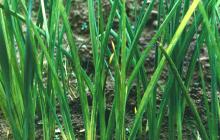Cause Iris mild mosaic virus (IMMV) and iris severe mosaic virus (ISMV) are problems for bulbous iris; iris fulva mosaic virus (IFMV) is a problem for rhizomatous irises. All are in the potyvirus group. Transmission by aphids is nonpersistent, however controlling aphid vectors has not been an effective control tactic. Bean yellow mosaic virus (BYMV), turnip mosaic virus (TuMV) and narcissus latent virus (NLV) have also been found. Less commonly found are cucumber mosaic virus, broad bean wilt virus, and tobacco ringspot virus. Spread can also be mechanically transmitted through vegetative propagation of infected stock.
Symptoms On bulbous iris, IMMV-infected plants may be stunted with yellowish streaks on leaves and dark, teardrop-shaped markings on white, blue, or lavender flowers. Clear, feathery markings may develop on yellow flowers. Iris are more severely affected if simultaneously infected with IMMV and ISMV, BYMV, or NLV. Symptoms also are more pronounced during cool, wet weather and on young foliage.
ISMV infected plants may exhibit chlorotic and mosaic leaves and color breaking in the flower petals. Heavily infected plants may also show stunted or distorted leaves or plant architecture, which may lead to premature death. However, asymptomatic infection has also been reported in ISMV-infected plants.
Iris fulva hybrids infected with IFMV have a mild mosaic, sometimes with leaf malformation.
Cultural control
- Plant pathogen-free stock.
- Isolate new shipments for an observation period. Locate the isolation area well away from existing blocks and scout regularly.
- Rogue all diseased plants.
- Plant resistant or symptomless cultivars.
References Barnett, O.W. 1986. Iris fulva mosaic virus. AAB Descriptions of Plant Viruses, No. 310. Wellesbourne, Warwick, U.K.: Association of Applied Biologists.
Brunt, A.A. 1986. Iris mild mosaic virus. AAB Descriptions of Plant Viruses, No. 324. Wellesbourne, Warwick, U.K.: Association of Applied Biologists.
Grunwald, D. J., Stroschein, S. M., Grinstead, S., Mollov, D., Rioux, R. A. and Rakotondrafara, A. M. 2023. Targeting the Highly Conserved 3′ Untranslated Region of Iris Severe Mosaic Virus for Sensitive Monitoring of the Disease Prevalence in Iris Production. Plant Disease, 107:3763-3772.



